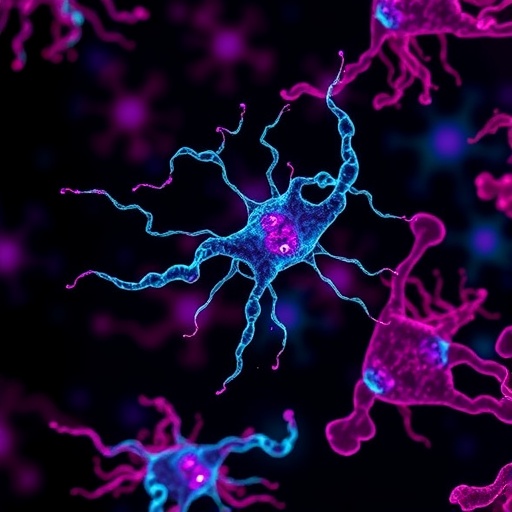
In recent years, the intersection of host-pathogen interactions has emerged as a critical field of study in microbiology, particularly concerning how pathogens can manipulate host physiology to thrive. A recent study by Fettucciari and colleagues sheds light on an intriguing aspect of this relationship: how Clostridioides difficile interacts with the adenosine system in the human body. This research unveils a sophisticated mechanism by which this bacterium not only survives but also exploits host homeostasis for its benefit.
Clostridioides difficile is primarily recognized for its role in antibiotic-associated diarrhea and colitis. This hazardous bacterium can produce toxins that disrupt gut homeostasis, leading to significant morbidity in affected individuals, particularly those with compromised immune systems or previous antibiotic treatments. Despite its notoriety, the underlying mechanisms that allow C. difficile to manipulate the host’s biological systems continue to be poorly understood, paving the way for studies like the one conducted by Fettucciari et al.
At the core of this research is the exploration of how C. difficile engages with the adenosine system, a network that plays a pivotal role in immune responses, inflammation, and cellular communication within the host. Adenosine is a nucleoside that influences numerous physiological processes, including vasodilation, neurotransmission, and immune modulation. When released during cellular injury or stress, adenosine triggers protective responses that can paradoxically facilitate the survival of pathogens.
In their study, the authors delve into the mechanisms by which C. difficile exploits adenosine signaling pathways. They present compelling evidence that this bacterium can manipulate the host’s adenosine levels to create a favorable microenvironment for its growth and persistence. This manipulation not only evades host immunity but also causes imbalances in the normal regulatory processes, underscoring the pathogen’s cunning nature.
The research highlights the role of specific adenosine receptors and their signaling cascades that are essential for maintaining homeostasis in the gastrointestinal tract. The authors utilized a variety of experimental models, including in vitro studies and animal models, to elucidate the interplay between C. difficile and the adenosine system, demonstrating how the bacterium influences these receptors in its favor.
Another critical aspect studied was the impact of C. difficile toxins on adenosine signaling. The toxins produced by this pathogen not only damage epithelial cells but also induce the release of adenosine triphosphate (ATP), which can be converted into adenosine. This local increase in adenosine amplifies the effects of immune modulation, allowing C. difficile to thrive amidst a weakened immune response. Such a dual strategy of toxicity and adenosine manipulation illustrates the complexity of host-pathogen interactions.
The findings of this study provide significant insights into the molecular dialogue between pathogens and their hosts. By unraveling the strategies employed by C. difficile to manipulate the adenosine system, researchers can identify potential therapeutic targets that could disrupt this interaction. Interventions aimed at modulating adenosine signaling may offer a novel approach to combat infections caused by this challenging pathogen.
Furthermore, this research draws attention to the broader implications of manipulating the adenosine system beyond C. difficile. Other pathogens may also exploit similar mechanisms to hijack host responses, highlighting the need for a deeper understanding of adenosine biology in infectious diseases. By comprehensively mapping these interactions, future studies could pave the way for innovative treatments that bolster the host’s defenses against a multitude of infections.
The authors conclude by urging the scientific community to focus on the therapeutic potential of targeting adenosine pathways as a means to treat C. difficile infections and potentially other related diseases. Such approaches could lead to the development of groundbreaking therapies that not only inhibit the pathogen but also restore homeostasis within the host.
In summary, the work by Fettucciari et al. provides a compelling narrative of how Clostridioides difficile interacts with the host through the adenosine system, turning the tide in its favor. Their findings encapsulate a significant leap toward understanding the complexity of host-pathogen interactions and open new avenues for therapeutic intervention against one of the most notorious pathogens in modern medicine.
Subject of Research:
The manipulation of the host adenosine system by Clostridioides difficile.
Article Title:
Clostridioides difficile meets the adenosine system: the art of manipulating host homeostasis.
Article References:
Fettucciari, K., Cari, L., Spaterna, A. et al. *Clostridioides difficile* meets the adenosine system: the art of manipulating host homeostasis. *J Biomed Sci* 32, 66 (2025). https://doi.org/10.1186/s12929-025-01160-8
Image Credits:
AI Generated
DOI:
Keywords:
Clostridioides difficile, adenosine, host-pathogen interactions, immune modulation, bacterial toxins.
Tags: adenosine system manipulationantibiotic-associated diarrheabacterial toxins and diseaseC. difficile and immune modulationcellular communication in infectionClostridioides difficilegut homeostasis disruptionhost-pathogen interactionsimmune system compromiseinflammatory responses to pathogensmechanisms of host manipulationmicrobiology research




